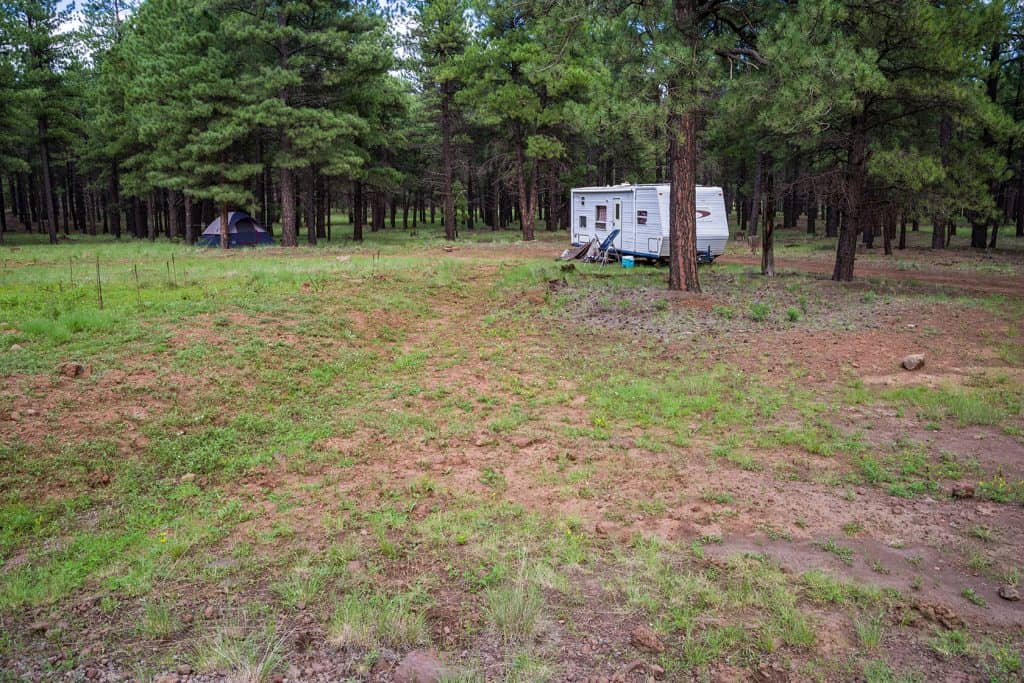
Newer owners object to the public accessing the Forest Service trails through easements by their property.
Michele Nelson/Roundup
This is one of our series of posts by the original authors summarizing, riffing on, and updating essays from the Steve Wilent-edited book 193 Million Acres. This is the second post on my essay on recreation: Wild and Free,.
***********************************
A brief foray into NVUM from 2018:
The Forest Service’s National Visitor Use Monitoring program (NVUM) website (www.fs.fed.us/recreation/programs/nvum/) provides a wealth of information about recreation visits and visitors at the forest, region, or national scale. Here are a few interesting statistics drawn from the most recent NVUM data (USDA Forest Service 2018):
- Most visitors (88 percent) use neither wilderness (0.05 percent) nor overnight developed sites (0.07 percent).
- Most visitors (95 percent) are somewhat or very satisfied.
- Approximately half (48 percent) of all visitors have a household income less than $75,000 per year.
- Half (50 percent) of the visitors travel less than 50 miles, and 75 percent of the visitors travel less than 200 miles.
The NVUM data at the national level indicate that national forest visitors are mostly local and semi-local people from a variety of incomes, who visit the forests for a variety of reasons and are mostly satisfied with their experiences.
Yet there is a growing crisis of funding and capacity.
********** Update: well, there’s a great deal more funding, but then Covid hit and the needs also went up. So today’s situation is very different than when I originally wrote the essay. I wonder what more recent NVUMs would say?
Maintain and Improve Access to Public Lands. This problem has been described in the paper “Landlocked: Measuring Public Land Access in the West,” by the Center for Western Priorities (2013): “The enclosure of public land can result from different circumstances. Lands may be completely surrounded by private lands without any right-of-way to access the adjacent public lands. There may be a public road running through private property which has been closed off. Public lands can be surrounded by private lands in a checkerboard pattern. Sometimes landowners have been known to illegally fence off public roads, effectively shutting out the public from crossing onto publicly-owned land.”
Neighbors to Forest Service land sometimes post no trespassing signs on legal public Forest Service roads. In the Rocky Mountain West, the center’s study estimates that four million acres of public land (Forest Service and BLM) do not have adequate access (defined as adjoining a road or adjoining other acres that adjoin a road). In 1993, a General Accounting Office study showed that an estimated 14 percent of Forest Service and BLM land nationally did not have adequate access (US General Accounting Office 1993).
Because access issues tend to be dealt with by the Forest Service Lands and Realty Management section staff personnel, these acknowledged and serious problems can be overlooked in discussions of recreation needs. These issues will require serious and sustained attention if the public lands are to be kept open for public use. In fact, the Forest Service may not be capable of handling this issue on its own. The lands staffs are overburdened, and at the end of the day, the Department of Justice may not have the capacity or the priorities to take many access cases to court. The problem of neighbors putting up signs could be reduced by focusing on making sure visitors have correct maps (clearly marked paper maps or correct maps via GPS apps on cell phones) and perhaps by posting standard signage on public roads through private land. The difficulties and lack of focus on the issue were described in a story by Marshall Swearingen in High Country News (Swearingen 2015).
In an ideal world, anyone would be able to easily access the half-billion acres managed by the Forest Service, the Bureau of Land Management and other federal agencies in the West. But I’m struck by how tenuous, even fragile, our connection to that land is — including the land in this particular corner of Montana, near my home in Bozeman: just thin threads of roads, where access often hangs more on the will of a landowner than on whether a road is truly public or private. Who gets to enjoy the benefits of public land, and at what cost, is more complicated than the crisply mapped property lines. And opening public access is always more difficult than closing it off.
Swearingen’s article outlines the importance of the work of the Public Land Water Access Association in Montana, a group of retirees and others that are focused on this issue and fund litigation to protect public access. Also, in Montana the State has stepped up to work on access, as reported in “Montana kicks off program to improve public land access,” in the Great Falls Tribune (Drake 2017). The article describes MT-PLAN, a new program approved by the state legislature, that “starts a contribution account and grant program to get public access easements to open up public land for recreation and aid public access sites statewide.” The program, overseen by the state Department of Natural Resources and Conservation, received $25,000 in seed money.
The Forest Service deals with forest visitors that are sometimes poorly behaved in ways that affect neighbors of forests and with some forest neighbors that are poorly behaved in ways that affect forest visitors. Ultimately, mediating these disputes are just about as local as it gets, and perhaps that’s why many of the national interest groups who want to protect public lands don’t seem to focus on or fund this work.
The Forest Service needs to bolster its efforts to deal with the access issue, but interested citizens need to step up as well. Perhaps federal public lands retirees could set up a group similar to Montana’s Public Lands and Waters Access Association (plwa.org), which has a mission to “maintain, restore, and perpetuate public access to the boundaries of all Montana public land and waters,” in other states and increase capacity to deal with this problem? A side benefit of volunteer activities would be that the efforts toward protecting access would be buffered from partisan political drama and administration philosophical and budget changes.
Land Designations by Congress or Presidents that Reduce Access. Much of the dialogue about the need for new wilderness areas or national monuments is about protecting the land from future possible activities like mineral extraction, timber harvesting, and grazing. Whether intentional or via a kind of policy collateral damage, access and recreation uses may be reduced or removed.
On its “Why Wilderness?” web page, the Wilderness Society (TWS) states that “Wilderness is a haven from the pressures of our fast-paced society. It provides us with places where we can seek relief from the noise, haste and crowds that too often confine us. It is a place for us to enjoy with friends and families — strengthening our relationships and building lasting memories.” (The Wilderness Society 2017)
However, NVUM numbers show that only 0.05 percent of national forest visits are in wilderness. And later, on the same webpage, TWS notes that: “Wild places are a great source of economic activity, especially in the rural communities that surround them. Outdoor recreation contributes more than $646 billion annually to the economy, supports 6.1 million jobs, and generates nearly $80 billion in federal, state, and local taxes.”
As part of its advocacy for increasing wilderness, TWS equates “wild areas,” where most people recreate, with legislated Wilderness. Since mountain bikes are not allowed in Wilderness, a push for more Wilderness necessarily reduces the diversity of recreation opportunities. As John Fisch comments in “Do Bikes Belong in Wilderness Areas?” in the December 20, 2017, edition of Sierra, the national magazine of the Sierra Club: “…bikes don’t belong in the backcountry… and all backcountry must become designated Wilderness. Ergo, the ultimate goal results in mountain bikes losing all backcountry access….” (Teasdale 2017).
It may be that increasing the number of acres in legislatively-designated wilderness areas and increasing, or even maintaining current access for the kinds of recreation that most visitors prefer (in NVUM data) are ultimately on a collision course.
****************** Update: perhaps the recent trend toward Monumentizing could be seen as a “protection with recreation” and as a substitute for Wilderness. And the question of which recreation, where, to be hashed out later during some less-sensationalized and tedious planning process.
Forest Service Decisions that Reduce Access. For a variety of reasons, the agency sometimes takes actions that reduce access, such as closing or decommissioning roads or trails because they are expensive to maintain or cause environmental harm. As an alternative, volunteers and partnerships are sometimes used to help reduce costs and environmental impacts.
Access via Guided Group Recreation. According to the Outdoor Industry Association (2017), “The agencies need to improve access to public lands and waters,” and the ways to improve it are to streamline permitting processes for guided and educational groups. These groups “afford urban youth and first-time recreationists the opportunity to get outside.”
The outdoor industry and others have a narrative that goes something like this, as stated by Myles Pham in “How Access to Public Lands Can Lead to Environmental Activism,” an October 17, 2017, Sierra Club blog post (Myles Pham (2017): “New participants are essential to growing the outdoor recreation economy and encouraging a new generation of climbers, fishers, and skiers. These kids will become the next generation of environmental advocates by virtue of protecting our public lands that give them joy.”
This is the instrumental view of increasing access for future consumers of outdoor products and environmental advocates. It is about increasing access for certain groups, such as urban youth and first-time recreationists, by making it easier to get to public lands in organized groups. It sounds like the idea is to make sure that in the future, people vote to “protect” public lands by increasing their recreation opportunities now. It could be argued that that will only encourage people to impact the land more (if we acknowledge that recreation has impacts) and lead to less ultimate “protection.”
Unless, of course, the concept of “protection” includes recreation of preferred types, still -even Wilderness is not protected from impacts of recreation. It’s all puzzling and seems illogical to me.
******Riffing.. in my career in the FS, when I couldn’t follow peoples’ logic, there was usually something they weren’t telling me. In this case perhaps we’ve entered some kind of ideological thicket.
*********Updating… perhaps funding should be used to focus on “protecting” land closer to marginalized communities, as per this study from 2022, for example.
The concept of access can clearly mean different things to different people. Everyone thinks that access to public lands is important but may disagree about who should get more access, who should get less access, and how much effort should be directed at maintaining and increasing public access through private lands. Access by recreationists of whatever kind has undeniable environmental impacts, and outdoor recreation is growing. How are these tensions to be managed?




